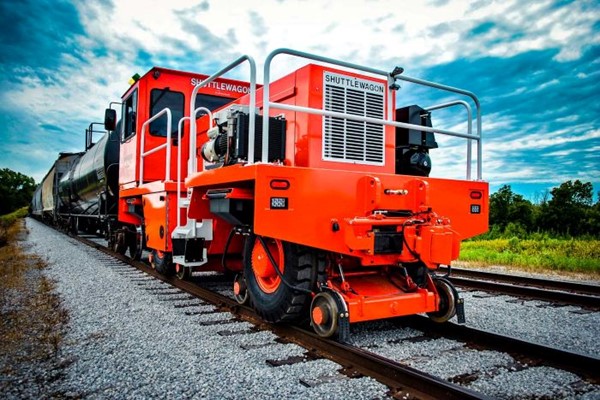Diesel vs Electric Railcar Movers
When it comes to the heavy lifting required in railcar operations, Shuttlewagon provides two main options to get the job done—electric zero emissions and diesel railcar movers. Both types are reliable and high performing, yet they differ in how they’re powered, which provides some advantages depending on your operational needs. Miami Industrial Trucks Inc. is a proud authorized dealer of Shuttlewagon models for businesses in Ohio, Kentucky, and West Virginia, including major cities such as Columbus, Cincinnati, Cleveland, Louisville, Lexington, Charleston, and Huntington, as well as Dayton, Findlay, Toledo, and Troy. To help you decide which option is best for you, we’ve detailed the key differences between electric and clean diesel technology. Read on to learn more about these two choices and browse through our Shuttlewagon products.
Power Source
The most prominent difference between electric and diesel Shuttlewagon railcar movers lies in their power source.
Electric railcar movers utilize battery power to deliver clean, efficient, and quiet performance. This makes them ideal for indoor environments, operations in areas requiring lower noise levels, and as an option that reduces dangerous volume levels for workers. Additionally, electric movers provide consistent power and torque, ensuring dependable performance, even with heavy loads. All of this does require access to charging infrastructure to keep running, which might limit flexibility in some cases. Shuttlewagon counters these challenges with features like fast-charging capability and regenerative braking, reducing downtime during operations.
Diesel railcar movers are powered by conventional diesel fuel, making them a practical choice for outdoor or remote worksites where charging may not be readily available. Diesel models deliver high top speeds but rely on engine rotation to generate torque, which may not offer the same consistency as battery-powered systems under heavy, sustained loads.
Environmental Impact
Another key consideration is the environmental footprint of your operations.
Railcars powered by batteries are the clear winner in terms of environmental friendliness. With zero emissions, they help reduce your carbon footprint and contribute to a healthier working environment. This eco-friendly advantage makes electric movers an excellent option for indoor job sites or regions with strict environmental regulations.
Diesel Railcar Movers, while reliable, produce emissions during operation and are less environmentally friendly. However, models such as the Commander NXT feature a Cummins Stage 5 engine for significantly reduced emissions compared to other engines. Another consideration is that diesel engines also produce more noise, which can create challenges in areas where sound reduction is necessary.
Operational Costs
Long-term operational costs can vary significantly between electric and diesel options.
Electric movers often have a higher upfront cost due to the advanced battery technology. However, they make up for this with lower long-term expenses. Electricity is often cheaper than diesel fuel, and electric movers typically have fewer maintenance needs as they don’t rely on complex engine components prone to wear and tear.
Diesel movers offer a lower initial investment, making them a more cost-effective choice for businesses just starting out. However, ongoing fuel expenses and maintenance requirements can add up over time. Diesel engines require regular servicing, and the cost of diesel fuel can fluctuate unexpectedly, potentially increasing your overall operational budget.
Performance
Performance needs often dictate the choice between an electric and diesel mover.
Battery-operated movers are known for their consistent power delivery and torque, making them highly effective for pulling heavy loads, even over steep inclines. They also feature stabilizing rail gear, which allows for enhanced maneuverability, tighter turns, and general ease of operation.
Diesel-powered movers tend to shine when it comes to higher top speeds and flexibility in remote environments. While they may not offer the same level of torque consistency, they’re dependable workhorses for outdoor or large-scale railcar operations.
Shuttlewagon Models Available
Miami Industrial Trucks Inc. is the exclusive authorized dealer of Shuttlewagon railcar movers in Ohio, including Dayton, Findlay, Toledo, and Troy. We offer a wide selection of these products to suit various industry requirements. Inventory options include the following models:
- Commander – The compact version, which features the same latest technology and interior comforts of the larger model, has tractive efforts ranging from 27,000 to 35,000 pounds across the three models.
- Commander NXT – The NXT has a pulling capability of 26,400 to 41,300 pounds across the four models for heavier loads.
- Navigator – The largest diesel railcar is available in four different models, with a pulling capacity of 38,000 to 60,000 pounds.
- SWXe Electric Railcar Movers – Designed for eco-conscious, high-performance needs, this compact electric series features eight different models, providing various options for heavy-duty tasks.
- NVXe – The NVXe is perfect for operators seeking electric efficiency alongside Shuttlewagon’s signature durability and performance standards.
With such a range of options, you can find the ideal railcar mover to match your operational requirements, be it diesel or electric.
Find the Right Railcar Mover for Your Operations
Choosing between a zero-emissions electric and diesel Shuttlewagon railcar mover depends on your preferences and needs. Consider factors like location, environmental priorities, and budget. Both options offer strengths, ensuring dependable performance and long-term value. Need help deciding? Miami Industrial Trucks Inc. is here to assist. Contact us today to learn more about our Shuttlewagon railcar movers, schedule a demo, or discuss the best options for your operation. We’re always happy to help you take your business operations to the next level.



